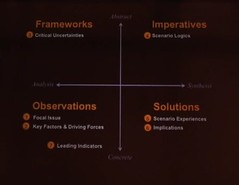Scenario planning is not about predicting or forecasting the future, but rather setting possible situations that occur in the long-term, then working backwards. Getting feedback from everyone in the organization, each member provides ideas, problems, situations, etc. that could unfold going forward (i.e., based on the established long-term timeframe). All of the ideas are collected and categorized, then grouped again into fewer themes, until three or four probably scenarios result. The idea is that virtually all of the feedback received from each member of the organization links to at least one of the four scenarios. Based on these few probable scenarios, current strategies are compared with any new strategies that would best prepare them for all possible scenarios that might unfold. Stakeholders begin working with these strategies in preparation for any of the possible scenarios that emerged from this analysis.
Scenario planning begins with a future situation that is probable and one that is based on the current situation. Afterwards, milestones with respective due dates are developed in reverse, back to the present. The point is to not rely solely on historical events, empirical evidence, and rational thought, but rather introduce more intuitive and creative thinking that lead to more qualitative and descriptive scenarios that harness organizational strategies, encompassing institutional mission and vision statements, objectives, and values. Scenario planning is meant to precede and complement more quantitatively-driven decision making, and does not set out to replace it.
